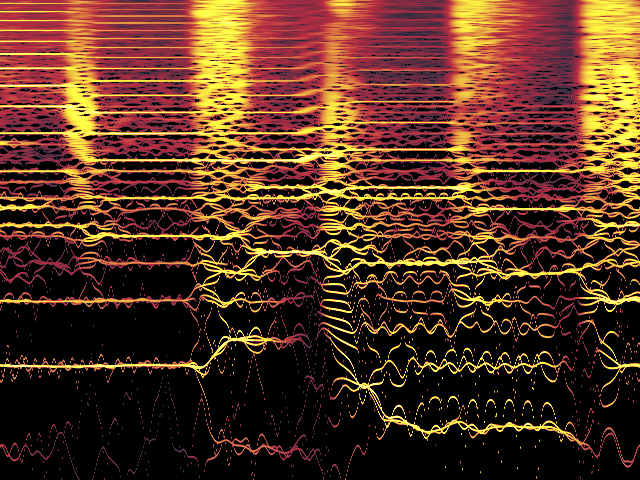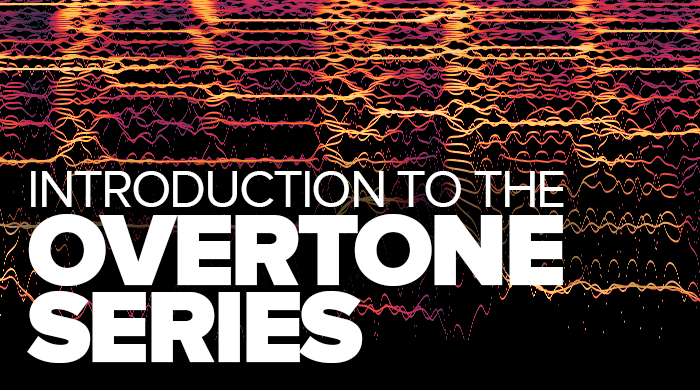A Short Lesson On The Nature Of Sound
Understanding the overtone series may seem at first to be a little abstract, and to an extent it is. But there is a beautiful mathematical simplicity to it that explains so much about the nature of music and sound, and it is worth your time learning to understand it.

As you may or may not know, any individual note you can sing or play on an acoustic instrument is actually a combination of multiple simultaneous pitches. For example, imagine you were to pluck the low open E string of a guitar. E will be the lowest sound you hear, and this is called the ‘fundamental’ or ‘first partial’. All the other sounds contained within that sound appear higher in pitch, which is why you have harmonic ‘overtones’, but not ‘undertones’.
There is a specific order of notes in the overtone series. But what is this order of notes? And why is this the order? Why do they even exist at all?! Let’s find out!
The harmonic overtones go up sequentially in exact multiples of the fundamental. For example, if you are playing a note that is 100Hz (Hz = Hertz, the number of vibrations per second), the first overtone above that is 200 Hz, then 300Hz, 400, 500 etc. As a note can be described mathematically (number of vibrations per second), any musical interval can be described as a ratio. And every interval has its own unique ratio. For example, a perfect octave is a 2 to 1 ratio (2 vibrations per second for every 1 vibration of the lower pitch in the interval). Double a note’s frequency and you get a perfect octave. This is why the second partial is always an octave, because it is exactly double the first partial.
The next note in the series, the third partial, is a 3 to 1 ratio with the fundamental. 3 to 1 is the ratio of a compound fifth, 3 to 2 is a regular fifth. The fourth partial is an octave again, and the fifth partial is a major third (two octaves apart). As the overtones go up in multiples, you end up with many different intervals from the fundamental, and therefore many different notes. In the image below, we can see the order of the overtones starting from the low C beneath the bass stave. (Remember that the exact notes in the overtone series will be different for every beginning note, but the intervals stay the same)

It’s worth noting that the first six partials are just the notes of a major triad. The partials higher up that are more dissonant with the fundamental are much softer and are very difficult to hear. So experiencing the major chord as harmonious is not some completely random anthropological phenomenon or cultural artefact, but actually written in to the nature of sound itself. However, how major 3rds and other partials sound in the harmonic series is different to how we actually tune our instruments, for practical necessities. For more information on this, check out a previous blog of mine on equal temperament HERE.
Whilst on the subject of what sounds are consonant, let’s have a brief look at the first overtone in the series: the octave. As the interval is a perfect double, the cycle time of each note fits very neatly in to a simple pattern the ear and brain can decode. The next interval in the series is the fifth, which is also very consonant and has a simple ratio of 3 to 2. As a general rule, the more consonant the interval, the simpler the ratio. For example, a major second has a ratio of 9 to 8. These two cycle times take a while to fit together, and the brain perceives this as dissonant.
You may now be thinking, ‘Why are there overtones anyway?’. This can be most easily understood with the example of the vibrating string. When you pluck a string, it vibrates along its whole length, producing the fundamental tone. But it also vibrates along all of the fractions of the string too. Both halves of the string vibrate, and so do three thirds of the string, four fourths etc. The whole string is doing a very complex pattern of wiggling at different lengths and producing different pitches, but all with a lower volume than the whole length of string. A similar thing is happening with wind instruments, but the string analogy is used more as it is easier to visualise (and literally see) than a column of vibrating air.
Musical instruments and voices will produce their own unique sound because the intensity of the individual overtones vary. For example, my voice may have a louder 2nd partial than yours, and your voice may have a louder 3rd partial than mine etc, and this is why our our voices sound different (excluding accent/depth etc). The exact same principle applies with acoustic musical instruments. The way their bodies resonate produces a unique combination of overtones at various volumes, and the instruments sound different from one another. I do have to clarify that it is an acoustic instrument phenomenon, because synthesisers are capable of producing a sound with no overtones at all, and this is called a sine wave.
The sounds produced by synthesisers provide a great example of the relationship between overtones and variety of sound, as the overtones are all precisely mathematically formulated and easy to understand. As sine waves have no overtones, they sound perfectly pure, just a completely clean tone. On the opposite end of the spectrum, we have the incredibly busy and buzzy sounding sawtooth wave. The reason it sounds so thick and rich (possibly too rich if anything) is because all of the overtones are there, and all at high volumes in relation to the fundamental. A square wave has only the odd numbered partials, so sounds less busy than the sawtooth. The triangle wave has the same partials as the square wave, but they are a third of the volume, so it sounds more pure, and closer to the sine wave.

That's all for today's lesson, but keep your eyes peeled, as there will be more about this subject coming out in the future.
If you enjoyed this lesson, make sure you check out our other blogs, and stay tuned for further lessons. If you’re serious about furthering your knowledge and your career in music, check out our Postgraduate and Premium courses on our website and see which ones are suitable for you. We’re always happy to help, so send us an email at contact@thinkspace.ac.uk with any questions and we’ll get back to you. Click the button below to take a look at our premium courses now.

